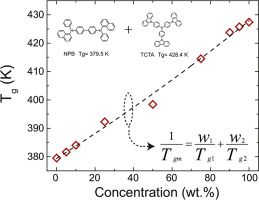Organic Electronics ( IF 2.7 ) Pub Date : 2018-05-22 , DOI: 10.1016/j.orgel.2018.05.025 Han-Nan Yang , Shou-Jie He , Tao Zhang , Jia-Xiu Man , Nan Jiang , Deng-Ke Wang , Zheng-Hong Lu

|
In a non-crystalline molecular material, glass-transition temperature Tg is typically defined by an inflection point in the specific volume (or thickness) vs. temperature plot. In this paper, the glass-transitions in thin-film organic semiconductors are investigated by using various temperature spectroscopic ellipsometer. We observed that glass transition temperatures in organic thin films are characterized by a disruptive change in thickness vs. temperature plot. In order to modify the glass transition temperature of an organic semiconductor, we also made composite thin-films by inclusion of another organic molecule with higher Tg. We found that the transition temperature can be significantly improved by inclusion of another organic molecule. The glass-transition processes of these composite semiconductors, however, also proceed in a disruptive manner, in stark contrast to typical polymeric materials. Despite this disruptive glass transition behavior, the experimental Tg of the composite semiconductors are found to follow precisely a simple inverse sum equation of constituent temperatures with their respective weight factors.
中文翻译:

纯有机薄膜和复合有机薄膜的玻璃化转变温度
在非晶态分子材料中,玻璃化转变温度T g通常由比体积(或厚度)对温度曲线的拐点定义。本文利用各种温度光谱椭偏仪研究了薄膜有机半导体中的玻璃化转变。我们观察到有机薄膜中的玻璃化转变温度的特征在于厚度与温度的关系曲线发生了破坏性变化。为了改变有机半导体的玻璃化转变温度,我们还通过加入另一种具有较高T g的有机分子来制备复合薄膜。。我们发现,通过包含另一种有机分子可以显着提高转变温度。然而,与典型的聚合物材料形成鲜明对比的是,这些复合半导体的玻璃化转变过程也以破坏性的方式进行。尽管具有这种破坏性的玻璃化转变行为,但是发现复合半导体的实验T g精确地遵循组成温度及其各自的权重因子的简单反求和方程。











































 京公网安备 11010802027423号
京公网安备 11010802027423号